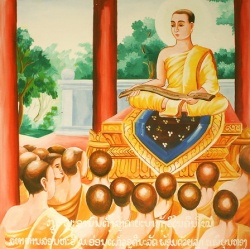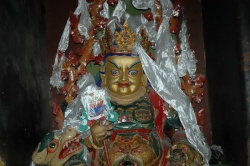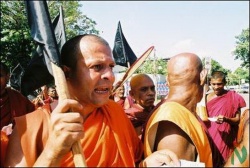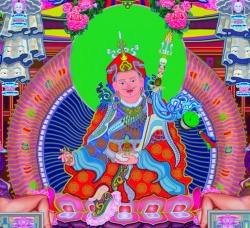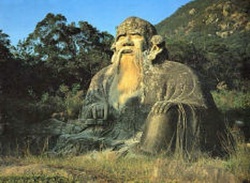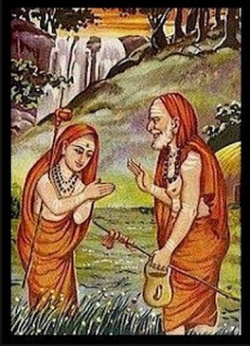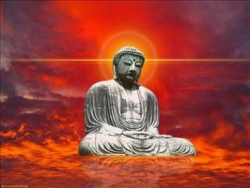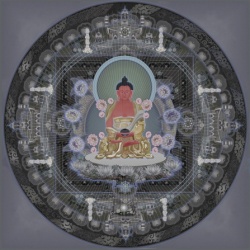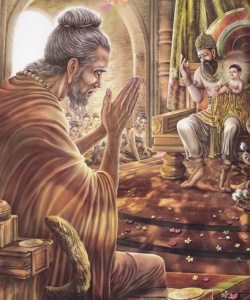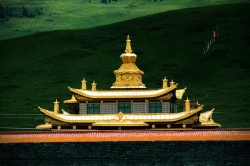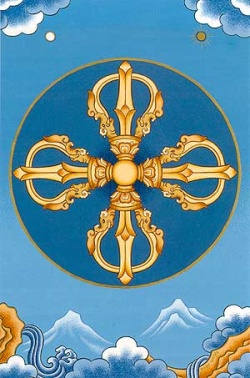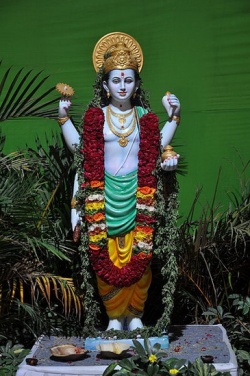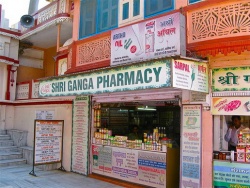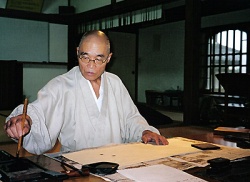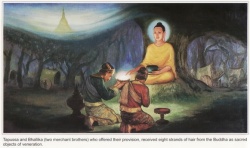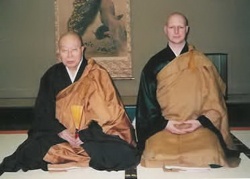Ayurveda
Click here to see other articles relating to word Ayurveda
Ayurveda (Sanskrit Āyurveda आयुर्वेद, "life-knowledge"; English pronunciation /ˌaɪ.ərˈveɪdə/ ) or ayurvedic medicine is a system of traditional medicine native to the Indian subcontinent and a form of alternative medicine.
The oldest known ayurvedic texts are the Suśruta Saṃhitā and the Charaka Saṃhitā.
These Classical Sanskrit encyclopedias of medicine are among the foundational and formally compiled works of ayurveda.
By the medieval period, ayurvedic practitioners developed a number of medicinal preparations and surgical procedures for the treatment of various ailments.
Current practices derived (or reportedly derived) from ayurvedic medicine are regarded as part of complementary and alternative medicine.
Safety concerns have been raised about Ayurveda, with two U.S. studies finding about 20 percent of Ayurvedic Indian-manufactured patent medicines contained toxic levels of heavy metals such as lead, mercury and arsenic.
Other concerns include the use of herbs containing toxic compounds and the lack of quality control in Ayurvedic facilities.
In classical Sanskrit literature, Ayurveda was called "the science of eight components" (Sanskrit aṣṭāṅga अष्टांग), a classification that became canonical for ayurveda.
They are:
Kāya-chikitsā: "cure of diseases affecting the body" (general medicine)
Kaumāra-bhṛtya "treatment of children" (paediatrics)
Śhalya-chikitsā Surgery, "removal of any substance which has entered the body (as extraction of darts, of splinters, etc.)"
Śālākya-tantra "cure of diseases of the eye or ear etc. by sharp instruments" (ophthalmology/ENT
Bhūta-vidyā "treatment of mental diseases supposed to be produced by demoniacal influence" (demonology / exorcism/psychiatry
Agada-tantra "doctrine of antidotes" (toxicology)
Rasayana-tantra "doctrine of elixirs"
Vājīkaraṇa tantra "doctrine of aphrodisiacs"
Principles and terminology
Several philosophers in India combined religion and traditional medicine—notable examples being that of Hinduism and ayurveda. Shown in the image is the philosopher Nagarjuna — known chiefly for his doctrine of the Madhyamaka (middle path)—who wrote medical works The Hundred Prescriptions and The Precious Collection, among others.
The three doṣas and the 5 elements from which they are composed.
Since Ayurveda is really the generic term for "traditional medicine" in India, actual practice may be widely divergent.
Descriptively, one may either focus on the historical foundation from the evidence of the earliest ayurvedic texts of the early centuries of the Common Era, or alternatively a description may take an ethnographic approach and focus on the forms of traditional medicine prevalent across India today.
Further information: Mahābhūta
Much like the medicine of classical antiquity, Ayurveda has historically taken the approach of enumerating bodily substances in the framework of the five classical elements
<poem>
(Sanskrit - maha panchabhuta; महा पञ्चभूत;, viz.
earth),
(water,
fire,
(air and
aether),
considering the seven "tissues" dhātu (Devanāgarī:
saptadhatu; सप्तधातु; of plasma
(rasa dhātu), blood
([[rakta [dhātu]]), flesh (māṃsa dhātu),
adipose (medha dhātu),
bone (asthi dhātu),
marrow (majja dhātu), and
reproductive (śukra dhātu).
Further information: Dosha
Ayurveda stresses a balance of three elemental substances (doṣa दोष), analogous to classical humorism: Vāyu / vāta (air & space – "wind"), pitta (fire & water – "bile") and kapha (water & earth – "phlegm").
One ayurvedic theory asserts that each human possesses a unique combination of doṣas that define that person's temperament and characteristics.
Each person has a natural systems state, or natural combination of the three elements, and should seek balance by structuring their behavior or environment to provide more of the element(s) they lack.
Another view, also present in the ancient literature, asserts that humoral equality is identical to health, and that persons with preponderances of humours are proportionately unhealthy, and that this is not their natural temperament.
Further information: Guna
In Ayurveda there are 20 fundamental qualities:
( guṇa गुण) inherent in all substances, arranged in ten pairs of antonyms:
heavy/light,
cold/hot,
unctuous/dry,
dull/sharp,
stable/mobile,
soft/hard,
non-slimy/slimy,
smooth/coarse,
minute/gross,
vicious/liquid.
Ensuring the proper functions of channels (srotas) that transport fluids from one point to another is a vital goal of ayurvedic medicine, because the lack of healthy srotas is thought to cause rheumatism, epilepsy, autism, paralysis, convulsions, and insanity.
Practitioners induce sweating and prescribe steam-based treatments as a means to open up the channels and dilute the doṣas that cause the blockages and lead to disease.
Hinduism and Buddhism have been an influence on the development of many of ayurveda's central ideas – particularly its fascination with balance,
known in Buddhism as Madhyathmaka (Sanskrit madhyatmika माध्यात्मिक Balance is emphasized; suppressing natural urges is seen to be unhealthy, and doing so claimed to lead to illness.
However, people are cautioned to stay within the limits of reasonable balance and measure.
For example, emphasis is placed on moderation of food intake, sleep, sexual intercourse. Practice
Ayurvedic practitioners approach diagnosis by using all five senses. Hearing is used to observe the condition of breathing and speech.
The study of the lethal points or marman marma is of special importance.
Ayurvedic doctors regard physical and mental existence together with personality as a unit, each element having the capacity to influence the others.
One of the fundamental aspects of ayurvedic medicine is to take this into account during diagnosis and therapy.
Hygiene is a central practice of ayurvedic medicine. Hygienic living involves regular bathing, cleansing of teeth, skin care, and eye washing.
Head massage is used to apply oils.
Ayurveda stresses the use of plant-based medicines and treatments.
Hundreds of plant-based medicines are employed, including cardamom and cinnamon.
Some animal products may also be used, for example milk, bones, and gallstones.
In addition, fats are used both for consumption and for external use. Minerals, including sulfur, arsenic, lead, copper sulfate and gold are also consumed as prescribed.
This practice of adding minerals to herbal medicine is known as rasa shastra.
In some cases, alcohol was used as a narcotic for the patient undergoing an operation.
The advent of Islam introduced opium as a narcotic.
Both oil and tar were used to stop bleeding.
Traumatic bleeding was said to be stopped by four different methods: ligation of the blood vessel; cauterisation by heat; using different herbal or animal preparations locally which could facilitate clotting; and different medical preparations which could constrict the bleeding or oozing vessels.
Various oils could be used in a number of ways, including regular consumption as a part of food, anointing, smearing, head massage, and prescribed application to infected areas.
The practice of panchakarma (Devanāgarī: पंचकर्म) is a therapeutic way of eliminating toxic elements from the body.
While two of the eight branches of classical Ayurveda deal with surgery ( Śalya-cikitsā, Śālākya-tantra), contemporary Ayurvedic theory tends to emphasize that building a healthy metabolic system, attaining good digestion, and proper excretion lead to vitality.
Ayurveda also focuses on exercise, yoga, and meditation.
Cataract in human eye – magnified view seen on examination with a slit lamp.
Cataract surgery is mentioned in the Sushruta Samhita in the early centuries of the first millennium AD, as performed with a special tool called the jabamukhi salaka, a curved needle used to loosen the obstructing phlegm and push it out of the field of vision. The eye would later be soaked with warm butter and then bandaged.
Ayurveda is a discipline of the upaveda or "auxiliary knowledge".
It is treated as a supplement or appendix of the Vedas themselves, usually either the Rigveda or the Atharvaveda.
The samhita of the Atharvaveda itself contains 114 hymns or incantations for the magical cure of diseases.
There are various legendary accounts of the "origin of ayurveda", e.g. that the science was received by Dhanvantari (or Divodasa) from Brahma Tradition also holds that a lost text written by the sage Agnivesh, a student of the sage Bharadwaja, influenced the writings of ayurveda.
There are three principal early texts on Ayurveda, all dating to the early centuries of the Common Era.
These are the Charaka Samhita, the Sushruta Samhita and the medical portions of the Bower Manuscript (a.k.a.. the Bheda Samhita).
The relative chronology of these texts is not entirely clear.
The Charaka Samhita is often cited as primary; although it survives in a recension of about the 4th or 5th century, it may be based on an original written between 100 BCE and 100 CE, which would have predated the other two texts.
The Sushruta Samhita was written in the 3rd or 4th century.
The Bower Manuscript is of particular interest because in this case the manuscript itself is ancient, dated to the early 6th century. The earliest surviving mention of the name Sushruta is from the Bower Manuscript.
The medical portions of the Bower Manuscript constitutes a collection of recipes which are connected to numerous ancient authorities, and may be based on an older medical tradition practiced during the Maurya period, antedating both the Charaka and the Sushruta Samhitas.
The Bower Manuscript is also of special interest to historians due to the presence of Indian medicine and its concepts in Central Asian Buddhism.
A. F. R. Hoernle in his 1897 edition identified the scribe of the medical portions of the manuscript as a native of India, using a northern variant of the Gupta script, who had migrated and become a Buddhist monk in a monastery in Kucha.
The Chinese pilgrim Fa Hsien (ca. 337–422 AD) wrote about the health care system of the Gupta empire (320–550) and described the institutional approach of Indian medicine, also visible in the works of Charaka, who mentions a clinic and how it should be equipped.
Other early texts, sometimes mentioned alongside the Sushruta, Chakaka and Bheda texts, are the Kasyapa and the Harita samhitas, presumably dating to the later Gupta period (ca. 6th century). Ayurvedic authors of the 7th or 8th century include Vagbhata ] and Madhava.
Underwood & Rhodes (2008) hold that this early phase of traditional Indian medicine identified "fever (takman), cough, consumption, diarrhea, dropsy, abscesses, seizures, tumors, and skin diseases (including leprosy)".
Treatment of complex ailments, including angina pectoris, diabetes, hypertension, and stones, also ensued during this period.
Plastic surgery, couching (a form of cataract surgery), puncturing to release fluids in the abdomen, extraction of foreign elements, treatment of anal fistulas, treating fractures, amputations, cesarean sections, and stitching of wounds were known.
The use of herbs and surgical instruments became widespread
The field of Ayurveda flourished throughout the Indian Middle Ages; Dalhana (fl. 1200), Sarngadhara (fl. 1300) and Bhavamisra (fl. 1500) compiled works on Indian medicine.
The medical works of both Sushruta and Charaka were also translated into the Arabic language during the 8th century. The 9th-century Persian physician Rhazes was familiar with the text.
The Arabic works derived from the Gupta era Indian texts eventually also reached a European audience by the end of the medieval period.
In Renaissance Italy, the Branca family of Sicily and Gaspare Tagliacozzi (Bologna) are known to have been influenced by the Arabic reception of the surgical techniques of Sushruta.
British physicians traveled to India to see rhinoplasty being performed by native methods.
Reports on Indian rhinoplasty were published in the Gentleman's Magazine in 1794.
Joseph Constantine Carpue spent 20 years in India studying local plastic surgery methods.
Carpue was able to perform the first major surgery in the western world in 1815.
Instruments described in the Sushruta Samhita were further modified in the Western World.
ppJoseph Constantine Carpue[[ based on this article was able to perform the "Indian" method of nose reconstruction and publish it in 1815.;
Current status
A typical ayurvedic Pharmacy, Rishikesh.
According to some sources up to 80 percent of people in India use some form of traditional medicines, a category which includes Ayurveda. ]
In 1970, the Indian Medical Central Council Act which aims to standardize qualifications for ayurveda and provide accredited institutions for its study and research was passed by the Parliament of India.
In India, over 100 colleges offer degrees in traditional ayurvedic medicine.
The Indian government supports research and teaching in ayurveda through many channels at both the national and state levels, and helps institutionalize traditional medicine so that it can be studied in major towns and cities.
The state-sponsored Central Council for Research in Ayurvedic Sciences (CCRAS) has been set up to research the subject.
To fight biopiracy and unethical patents, the Government of India, in 2001, set up the Traditional Knowledge Digital Library as repository of 1200 formulations of various systems of Indian medicine, such as ayurveda, unani and siddha. The library also has 50 traditional ayurveda books digitized and available online.
Central Council of Indian Medicine (CCIM) a statutory body established in 1971, under Department of Ayurveda, Yoga and Naturopathy, Unani, Siddha and Homoeopathy (AYUSH), Ministry of Health and Family Welfare, Government of India, monitors higher education in ayurveda.
Many clinics in urban and rural areas are run by professionals who qualify from these institutes.
Sri Lanka
The Sri Lankan tradition of Ayurveda is very similar to the Indian tradition.
Practitioners of Ayurveda in Sri Lanka refer to texts on the subject written in Sanskrit, which are common to both countries.
However, they do differ in some aspects, particularly in the herbs used.
The Sri Lankan government has established a Ministry of Indigenous Medicine (established in 1980) to revive and regulate the practice within the country The Institute of Indigenous Medicine (affiliated to the University of Colombo) currently offers undergraduate, postgraduate, and MD degrees in the practice of Ayurveda Medicine and Surgery, and similar degrees in unani medicine.
There are currently 62 Ayurvedic Hospitals and 208 central dispensaries in the public system, and they served almost 3 million people (approximately 11 percent of Sri Lanka's total population) in 2010. In total there are currently approximately 20,000 registered practitioners of Ayurveda in the country.
Many Sri Lankan hotels and resorts offer Ayurveda themed packages, where guests are treated to a wide array of Ayurveda treatments during their stay.
Ayurveda is a system of traditional medicine developed during antiquity and the medieval period, and as such comparable to pre-modern Chinese and European systems of medicine.
However, beginning in the 1960s, Ayurveda has begun to be advertised as "alternative medicine" in the West.
Due to different laws and medical regulations in the rest of the world, the unregulated practice and commercialization of ayurvedic medicine has raised ethical and legal issues.
In some instances, ayurvedic practices or terminology have also been adapted specifically for Western consumption, notably in the case of "Maharishi Ayurveda" in the 1980s;
in some cases, this has involved active fraud on the part of proponents of Ayurveda in an attempt to falsely represent the system as amenable to the standards of modern medical research. ]
Scientific appraisal
In studies in mice, the leaves of Terminalia arjuna have been shown to have analgesic and anti-inflammatory properties.
As a traditional medicine, many ayurveda products have not been tested in rigorous scientific studies and clinical trials.
In India, research in ayurveda is undertaken by the statutory body of the Central Government, the Central Council for Research in Ayurveda and Siddha]] (CCRAS), through a national network of research institutes.
A systematic review of ayurveda treatments for rheumatoid arthritis concluded that there was insufficient evidence, as most of the trials were not done properly, and the one high-quality trial showed no benefits.
A review of ayurveda and cardiovascular disease concluded that the evidence for ayurveda was not convincing, though some herbs seemed promising.
Two varieties of Salvia have been tested in small trials;
one trial provided evidence that Salvia lavandulifolia (Spanish sage) may improve word recall in young adults, and another provided evidence that Salvia officinalis (Common sage) may improve symptoms in Alzheimer's patients.
Many plants used as rasayana (rejuvenation) medications are potent antioxidants.
Neem appears to have beneficial pharmacological properties. Turmeric and curcumin have shown effectiveness in preventing and treating cancer.
Recently, there are some PubMed indexed journals being published in the field of Ayurveda.
Safety
Rasa shastra, the practice of adding metals, minerals or gems to herbs, may have toxic heavy metals such as lead, mercury and arsenic.
Adverse reactions to herbs due to their pharmacology are described in traditional ayurvedic texts, but ayurvedic practitioners are reluctant to admit that herbs could be toxic and that reliable information on herbal toxicity is not readily available.
And there is communication gap between modern medicine practitioners and Ayurvedic practitioners
According to a 1990 study on ayurvedic medicines in India, 41 percent of the products tested contained arsenic, and 64 percent contained lead and mercury.
A 2004 study found toxic levels of heavy metals in 20 percent of ayurvedic preparations made in South Asia and sold in the Boston area, and concluded that ayurvedic products posed serious health risks and should be tested for heavy-metal contamination.
A 2008 study of more than 230 products found that approximately 20 percent of remedies (and 40 percent of rasa shastra medicines) purchased over the Internet from both US and Indian suppliers contained lead, mercury or arsenic.
In 2012 the U.S. Centers for Disease Control and Prevention (CDC) stated that Ayurvedic drugs have been linked to lead poisoning on the basis of some cases where pregnant women had taken Ayurvedic drugs and toxic materials were found in their blood.
Ayurvedic proponents believe that the toxicity of these materials is reduced through purification processes such as samskaras or shodhanas (for metals),
similar to the Chinese pao zhi, although the ayurvedic technique is more complex and may involve prayers as well as physical pharmacy techniques.
However, these products have nonetheless caused severe lead poisoning and other toxic effects.
Due to these concerns, the Government of India ruled that ayurvedic products must specify their metallic content directly on the labels of the product, but,
writing on the subject for Current Science, a publication of the Indian Academy of Sciences, M. S. Valiathan noted that "the absence of post-market surveillance and the paucity of test laboratory facilities [in India) make the quality control of Ayurvedic medicines exceedingly difficult at this time.
</poem>
